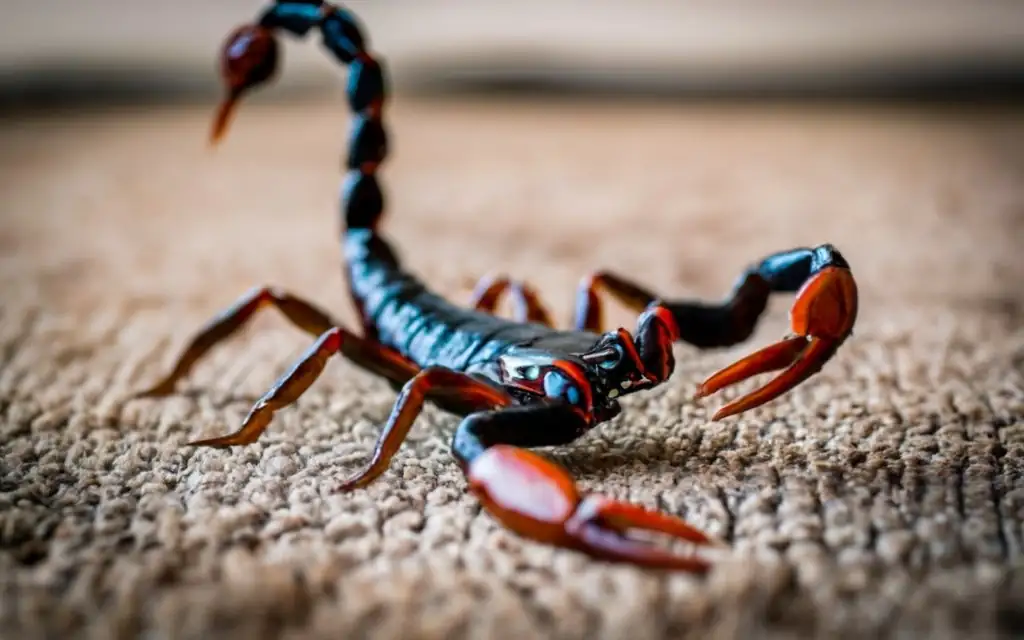Last updated on October 29th, 2023 at 02:18 am
Scorpions on carpet – a phrase that can send shivers down your spine, especially if you reside in an area where these arachnids are common houseguests. Scorpions are intriguing creatures, but when they make their way into your home, it’s not a welcome sight. In this article, we’ll delve into the world of scorpions, their fascination with indoor environments, and most importantly, how to keep them out of your house.
How to Keep Scorpions Out of Your Home
Scorpions are not invited guests, so it’s essential to know how to prevent them from entering your home. Here are some proven methods to keep these arachnids at bay:
- Seal Entry Points: Scorpions can slip through small openings. Seal cracks, gaps, and holes in your home’s foundation, windows, and doors to prevent their entry.
- Landscaping: Maintain a tidy yard. Trim shrubs and keep firewood, debris, and rocks away from the house; these can serve as hiding spots for scorpions.
- Lighting: Scorpions are drawn to light. Replace white outdoor bulbs with yellow or amber ones to reduce their attraction.
- Professional Pest Control: When infestations become severe, seek professional pest control services to manage the issue effectively.
Are Scorpions Commonly Found in Homes?
The presence of scorpions in homes largely depends on the geographic location of the home and the local environment. Scorpions are more commonly found in certain regions, such as arid or semi-arid areas, where they thrive in dry and warm climates. They tend to hide in cool, dark, and sheltered places during the day and come out at night to hunt for insects and other prey.
In some parts of the world, like the southwestern United States, the Middle East, and parts of Africa, scorpions are more common in and around homes. However, in many other regions, scorpions are rare or absent.
If you live in an area where scorpions are prevalent, it’s possible to encounter them in and around your home. Taking preventive measures like sealing cracks and crevices, using weather stripping on doors and windows, and keeping the home clean and uncluttered can help reduce the likelihood of scorpions entering your living space. In some cases, people may use professional pest control services to manage scorpion populations.
It’s important to note that while scorpions can be venomous and deliver painful stings, not all species of scorpions are dangerous to humans. In areas where scorpions are common, it’s wise to be cautious and educate yourself on the local species to know which ones may pose a threat. If you do encounter a scorpion in your home and are concerned about its potential danger, it’s best to contact local pest control or wildlife authorities for guidance on safe removal.
What Attracts Scorpions to Your House?
To effectively prevent scorpions from entering your home, it’s vital to understand what draws them inside. Some common attractants include:
- Dark and Damp Areas: Scorpions seek shelter in dark, cool, and damp spaces.
- Food Sources: Scorpions prey on insects. If you have a bug problem, it might attract scorpions.
- Cracks and Crevices: Scorpions use these as entry points, so sealing them is crucial.

Do Scorpions Hide in Carpets, Rugs, or Under Them?
Scorpions are known for their ability to hide in a variety of dark, sheltered places during the day, and this can include carpets, rugs, or underneath them. However, whether they hide in these areas depends on the scorpion’s environment and the specific conditions of the home.
Scorpions are nocturnal creatures, so during the day, they seek out cool and dark hiding spots to avoid exposure to light and heat. Carpets and rugs on the floor can provide such hiding places. They may also find their way into shoes, clothing, or other items left on the floor.
How to Identify Scorpion Infestations in Your House
Recognizing a scorpion infestation is vital for taking action. Here are some signs to look out for:
- Shed Exoskeletons: Scorpions shed their exoskeletons, leaving them behind.
- Scorpion Droppings: Their droppings resemble small pellets.
- Sightings: If you spot a scorpion, there may be more lurking.
Scorpion-Proofing Your Home: Tips and Tricks
To make your home less appealing to scorpions, follow these expert tips:
- Regular Cleaning: Keep your home clean and clutter-free.
- Pest Control: Address other insect issues to reduce the scorpions’ food source.
- Weather Stripping: Ensure doors and windows seal properly.
- Dehumidify: Scorpions dislike dry environments.
Natural Remedies for Keeping Scorpions Away from Your Carpets and Rugs
If you prefer natural solutions, here are some remedies to deter scorpions from your carpets and rugs:
- Cedar Oil: Sprinkle cedar oil in areas where scorpions might hide.
- Citrus Peels: Leave citrus peels around carpets – scorpions dislike the scent.
- Diatomaceous Earth: A non-toxic powder that can be sprinkled around carpet edges.
Are Scorpion Stings Dangerous? What to Do If You Encounter One Indoors
Scorpion stings can vary in severity, but they are generally not life-threatening. However, knowing what to do if you encounter a scorpion indoors is crucial:
- First Aid: Clean the sting area and apply a cold pack.
- Seek Medical Attention: If symptoms are severe, consult a healthcare professional.
- Capture the Scorpion: If possible, catch the scorpion for identification purposes.
Common Types of Scorpions Found in North America
The United States is home to several scorpion species. Understanding them can help you identify potential intruders:
| Scorpion Type | Habitat | Characteristics |
|---|---|---|
| Bark Scorpion | Southwest | Small, light-colored, and highly venomous. |
| Striped Scorpion | Western US | Yellowish-brown with distinct stripes. |
| Giant Desert Hairy Scorpion | Desert Regions | Large and covered in hair. |
Here are more of the notable scorpion species found in North America:
- Arizona Bark Scorpion (Centruroides sculpturatus): This is one of the most venomous scorpions in North America. It is commonly found in the southwestern United States, particularly in Arizona. Their venom can cause severe pain, though fatalities are rare, especially with prompt medical treatment.
- Striped Bark Scorpion (Centruroides vittatus): These scorpions are also found in the southwestern United States and are less venomous than the Arizona bark scorpion. Their stings can be painful but are generally not life-threatening.
- Bark Scorpions (Several species): Besides the Arizona and Striped bark scorpions, there are several other species of bark scorpions found in the southwestern United States and Mexico. Some of these include the Southern Devil Scorpion (Vaejovis carolinianus) and the Giant Hairy Scorpion (Hadrurus arizonensis).
- Texas Cave Scorpion (Pseudouroctonus reddelli): This species inhabits caves and rocky areas in parts of Texas and New Mexico.
- Dessert Hairy Scorpion (Hadrurus spp.): These are some of the largest scorpions in North America and can be found in desert regions in the southwestern United States.
- Northern Scorpion (Paruroctonus boreus): Found in various parts of North America, including the western United States, this species is typically not dangerous to humans.
- Eastern Sand Scorpion (Paruroctonus boreus): As the name suggests, these scorpions are found in eastern parts of the United States, including the Midwest and the Great Plains. Their stings are usually mild.
- Striped Scorpion (Centruroides spp.): These scorpions are found in parts of the southern United States and are generally not considered medically significant.
It’s important to note that while scorpions can deliver painful stings, the vast majority of scorpion species in North America are not life-threatening to humans. However, if you are stung by a scorpion, it’s always a good idea to seek medical attention, especially if you are uncertain about the species or if the symptoms are severe.
What Are Scorpions Looking for in Indoor Environments?
Scorpions have specific requirements when venturing indoors. Here’s what they’re seeking:
- Shelter: Dark, secluded spaces to hide.
- Moisture: Scorpions need water to survive.
- Prey: Insects and other small creatures to feed on.
I Found a Scorpion in My House, Are There More?
Discovering a scorpion indoors can be unsettling. Here’s how to handle the situation:
- Inspect Your Home: Conduct a thorough inspection of your home, paying close attention to areas where scorpions could hide, such as dark, cool, and sheltered spots. Check areas like closets, basements, attics, and under furniture. Use a flashlight to help with your search.
- Seal Entry Points: Scorpions can enter your home through cracks, gaps, or openings in walls, doors, and windows. Seal these entry points with caulk or weather stripping to prevent more scorpions from getting in.
- Remove Hiding Places: Reduce potential hiding spots by keeping your home clean and uncluttered. Decluttering can make it less hospitable for scorpions.
- Install Door Sweeps: Install door sweeps on exterior doors to create a barrier against scorpions and other pests.
- Use Sticky Traps: Place sticky traps in areas where you suspect scorpions may be hiding. These traps can help you monitor the presence of scorpions in your home.
- Call a Pest Control Professional: If you continue to find scorpions or if you have concerns about their presence in your home, consider contacting a pest control professional who specializes in dealing with scorpions. They can assess the situation, provide guidance on prevention, and help eliminate any existing scorpion populations.
If you live in an area where venomous scorpions are common, it’s wise to take precautions to prevent their entry and reduce the risk of stings, especially if you have small children or pets in the home.
How Do Scorpions Get Upstairs?
If you’re wondering how scorpions end up on upper floors, here’s the explanation:
- Climbing Walls: Scorpions are excellent climbers and can scale rough surfaces, such as the exterior walls of a building. They can use tiny gaps, cracks, or irregularities in the wall to gain access to higher levels.
- Climbing Stairs: If your home has outdoor stairs or steps leading to an upper level, scorpions can climb these surfaces to reach higher areas. It’s important to seal any gaps or cracks in the stair structure to prevent them from using these routes.
- Open Windows: Scorpions might enter a building through open windows, especially if they are on or near the ground floor. Make sure to use screens on windows to keep them out.
- Open Doors: Scorpions can crawl under doors with gaps or openings. Installing door sweeps or weather stripping on exterior doors can help keep them from entering.
- Plants and Vines: If you have vegetation near your home that comes in contact with windows or walls, scorpions could use plants and vines as pathways to climb higher. Trimming or relocating vegetation away from the structure can help prevent this.
- Air Ducts or Vents: In some cases, scorpions may enter a building through HVAC vents, especially if the vent covers are damaged or missing. Regularly inspect and maintain these openings to prevent entry.
- Clothing and Objects: Scorpions can also climb up objects like clothing or bags left on the floor or stairs, eventually reaching higher levels of the building. Shake out and inspect these items before handling them.
Where Do Scorpions Like to Hide in Houses?
Scorpions are skilled hiders. Common hiding spots in houses include:
- Dark, Cool, and Damp Areas: Scorpions are nocturnal creatures that prefer to stay in dark and cool areas during the day. Basements, crawl spaces, and utility rooms are prime hiding spots, especially if they have moisture.
- Closets and Cabinets: Scorpions may seek refuge in closets and cabinets, particularly if these areas are cluttered, providing them with numerous hiding spots.
- Under Furniture: Scorpions can hide under sofas, chairs, beds, and other pieces of furniture. They can slip into narrow crevices or hide underneath these items.
- Behind Wall Hangings: Wall hangings, such as picture frames or wall-mounted shelves, can provide concealed spaces where scorpions can hide.
- In Laundry Rooms: Scorpions are attracted to the moisture in laundry rooms and might hide behind washing machines, dryers, or laundry baskets.
- In Footwear and Clothing: Shoes, boots, and clothing left on the floor can be enticing hiding spots for scorpions. Always check your footwear and clothes before putting them on.
- Cracks and Crevices: Scorpions can squeeze through tiny gaps and cracks in walls, floors, and ceilings. They may hide inside these openings during the day.
- In Cluttered Areas: Cluttered areas, including storage spaces, garages, and attics, can provide multiple hiding places for scorpions. Reducing clutter can make it less hospitable for them.
- Near Heat Sources: Scorpions may seek warmth from heat sources like appliances, water heaters, or heating vents. Inspect these areas for scorpion activity.
- Vegetation: If your home has dense vegetation close to the structure, scorpions can hide in plants and use them as pathways to enter the house.
To prevent scorpions from hiding in your home, it’s essential to keep your living spaces well-maintained and reduce potential hiding spots. This includes sealing cracks and gaps, decluttering, using weather stripping on doors and windows, and taking other measures to make your home less appealing to scorpions. If you suspect a scorpion infestation or are concerned about their presence, consider contacting a pest control professional for assessment and treatment.
What Do Scorpions Hate?
Scorpions have certain dislikes that you can use to your advantage:
- Cedar: Scorpions dislike the scent of cedar.
- Light: Scorpions are nocturnal and dislike bright lights.
- Peppermint Oil: A peppermint oil spray can deter them.
Can Scorpions Climb Walls?
Yes, scorpions can climb walls and other vertical surfaces. They possess specialized structures on their bodies that allow them to do so.
Where Do Scorpions Hide Outside?
Scorpions have their outdoor hiding spots as well, which may include:
- Under rocks
- In burrows
- Beneath logs
Now that you’re armed with knowledge about scorpions and how to prevent them from invading your home, you can take the necessary steps to ensure your living space remains scorpion-free. By understanding their habits and dislikes, you can coexist with these fascinating creatures while keeping them at a respectful distance. Remember, knowledge is your best defense against these elusive arachnids.
For authoritative information on scorpions and pest control, consider visiting the National Pest Management Association. They offer valuable resources and guidance on various pest-related issues.



